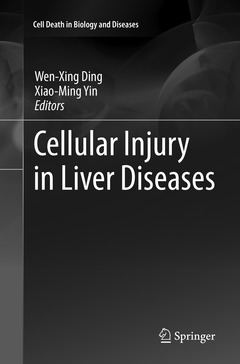Description
Cellular Injury in Liver Diseases, 1st ed. 2017
Cell Death in Biology and Diseases Series
Coordinators: Ding Wen-Xing, Yin Xiao-Ming
Language: English
Subjects for Cellular Injury in Liver Diseases:
158,24 €
Disponible chez l'éditeur (délai d'approvisionnement : 15 jours).
Add to cartPublication date: 08-2018
Support: Print on demand
158,24 €
Disponible chez l'éditeur (délai d'approvisionnement : 15 jours).
Add to cartPublication date: 05-2017
Support: Print on demand
Résumé
/li>Sommaire
/li>Biographie
/li>Commentaire
/li>
This volume has gathered together some of the world?s experts on cell death in liver diseases, covering topics on a variety of types of liver injury. Specifically, the chapters of this volume describe drug and virus-mediated hepatocyte injury, alcohol, lipid and bile acid-induced hepatocyte injury in addition to ischemia-reperfusion-mediated liver injury. The authors link these different types of liver injury to the commonly associated liver inflammation, fibrosis and tumorigenesis. Other topics explored include the various forms of cell death and cell survival pathways that have been identified in the liver, such as apoptosis, necroptosis, pryoptosis and autophagy. This book, along with its companion volume, Molecules, Systems and Signaling in Hepatic Cell Death, provides a thorough and comprehensive discussion on the topic of cell death and liver disease. Cellular Injury in Liver Diseases is an essential addition to the Cell Death in Biology and Diseases series and will appeal to scientists, clinicians and those doing research for drug discovery.
Preface.- 1) Regulation of cell death in Hepatocytes, An overview .- 2) Cell death of cholangiocytes and its role in the development of biliary diseases .- 3) Cell death and autophagy in hepatic stellate cell activation and function .- 4) Regulation of Kupffer’s cell death, survival and activation during liver injury .- 5) Drug-induced liver injury (DILI), a general overview .- 6) Mechanisms of acetaminophen-induced liver injury .- 7) HIV-protease inhibitor-induced liver injury .- 8) Mechanisms of Lipotoxicity in Liver Injury .- 9) Cell Death in NAFLD and NASH .- 10) Cell death and autophagy in alcohol-induced liver injury .- 11) Bile acid-induced cell death, cholestasis and liver injury .- 12) Cell death in ischemia-reperfusion induced liver injury .- 13) Lectin (ConA)-induced liver injury and autoimmune hepatitis .- 14) Cell death and autophagy in viral hepatitis .- 15) Cell death and autophagy in liver tumorigenesis and liver cancer.
Provides thorough, comprehensive discussion of the topic with enough breadth to appeal to scientists, clinicians and those doing research for drug discovery
Contributors contribute worldwide expertise and perspective and are all leaders in their fields
Illustrations and tables throughout enhance and complement the text
Includes supplementary material: sn.pub/extras




